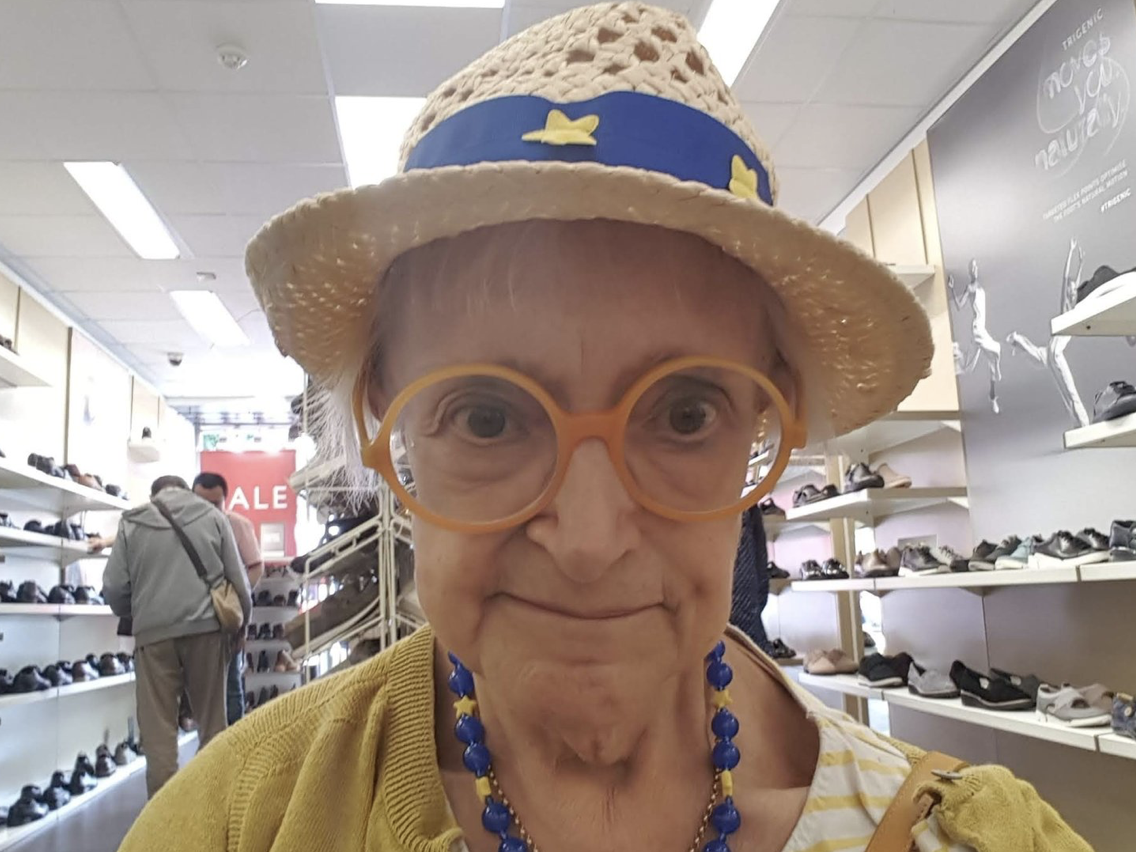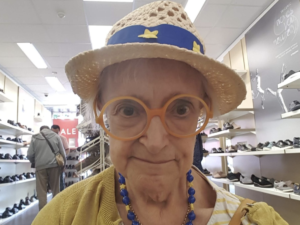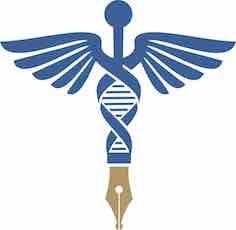

Caroline Richmond: A remarkable woman, a remarkable life
Caroline Richmond, who died on Christmas Eve, was an outspoken and fearless journalist as well as founder of HealthWatch, the charity dedicated to stop quacks and dodgy doctors preying on the sick and vulnerable. At the 2023 MJA annual meeting in November, she was made an honorary member of the Association. Conferred only by an AGM vote, this very occasional accolade recognises services to the MJA or ‘distinction in the fields of journalism or healthcare’. Caroline was also a former co-ordinator of Women in Media and former vice-chair of the Association of British Science Writers.
John Illman writes: I interviewed Caroline two months ago. I knew she was dying and she knew I knew — that was the point. This may sound morbid, but I had a front-row seat in a celebration of an extraordinary life. Caroline’s great zest for living did not waver in our three hours together — and she was, as ever, great company, and, again as ever, full of contradictions: both compassionate and biting; and scrupulous but mischievous.
A classic example of mischievous Caroline was the great bright clothes spoof — let me put this is into context. Caroline loved bright clothes and large moon-shaped coloured spectacles. I remember meeting her at a party and thinking: Who is this woman?
Back to the story: in 1987 the BMJ published, as part of its traditional fun Christmas edition, Caroline’s spoof attributing the obesity epidemic to bright clothes. Un-dyed clothes, it added, had ‘cured or improved’ hyperactive children. Claiming un-bleached and un-dyed clothes were only available from health food shops, it called upon readers to campaign for “additive free clothes for your sake and your children’s”.
The leaflet was ‘published’ by a body the very opposite of bright — namely ‘DRAB (The Dye-Related Allergies Bureau, a subsidiary of the Food Additives Research Team (FART)’.
Allergy panic
Explaining the background, she said: “In the 1980s, there was panic about food additives. I wrote an article in New Scientist arguing that most of the case against additives was based on fallacies. This met with a barrage of protest, much of it vicious. I found it most upsetting.
“To cheer myself up, I invented an allergy.”
But it was taken seriously. People wrote to Caroline about their bright clothes allergies. The late Amelia Nathan-Hill, founder of Action Against Allergy (AAA) even insisted that dye-related allergies were real — after being told that it was a spoof. Moreover, she thanked Caroline and published it in the AAA newsletter.
This may seem amusing, but it highlighted the vulnerability of susceptible patients, especially in the 1980s to claims around supposed allergies to food and the environment. Caroline recalled patients convinced that they were “totally allergic to the 20th century”. Some even went to Dallas, living in hermetically sealed bubbles, watched over by “a phalanx of dubious doctors, ready to humour them for a suitable fee”.
Serendipity
Here was the rationale for HealthWatch. Serendipity helped to make it happen.
In 1987 Vincent Marks, professor of biochemistry, University of Surrey and a world authority on insulin, recognised Caroline as a ‘kindred spirit’. Over lunch at a meeting in London where they were both speakers, he told her about the US National Council Against Health Fraud. Caroline set about creating the UK equivalent.
The Campaign Against Health Fraud (CAHF), later renamed Health Watch and then HealthSense, had an illustrious founder membership, thanks to Caroline’s persuasive powers. It included Marks; Diana Brahams, legal correspondent, The Lancet and later editor-in-chief of the Medico-Legal Society; John Garrow, professor of human nutrition, University of London; Michael Baum, professor of surgery, King’s College, London; and BBC TV Crimewatch presenter Nick Ross.
Baum had just introduced Ross to patients whose breast cancers had disintegrated into suppurating sores because they had shunned effective conventional treatment for unproven alternatives such as homeopathy.
Ross, president of HealthSense, recalled: “I soon discovered that Caroline and I shared a corresponding passion for the flipside of quackery: the flimflam in conventional medicine caused by commercial pressures on pharma’, egoism in academe, and from medical professionals steeped in old-fashioned and often poorly evidence-based ways of doing things.
Campaigns against quackery
“After CAHF was renamed HealthWatch (and later HealthSense) it was Caroline as much as anyone who helped us transition from a campaign against quackery into a campaign for evidence-based medicine (EBM).”
Early quack-busting included a tip-off from an anonymous member leading to the ‘defrocking’ of a bogus doctor. Another member, David Pearson, reader in medicine at Manchester University, pointed out dangerous and misleading errors in Women’s Journal. Garrow, later chair of HealthWatch, and Marks individually complained to the BBC Today programme about “nutrition misinformation that included a bogus vitamin and perpetuation of the diet-hyperactivity myth”.
It would have been hard to envisage young Caroline becoming the catalyst of a pioneering healthcare charity and a champion of the NHS. The daughter of Cedric Ivor Smith, an Indian civil servant and an “abusive” father, and his wife Kathleen (née Meeson), she had a dysfunctional childhood. A self-confessed troublesome child, she was expelled from Richmond Grammar School for Girls; sacked from an office job for absenteeism; and thrown out of the old Sir John Cass College after completing two years as a zoology undergraduate. After completing her course in Portsmouth, she began a neuroscience PhD at UCL, only to quit after two years because of an impasse with her boss. She did “enjoy” a masters in physiology at Birkbeck.
Academia might have been ambivalent about Caroline pursuing a scientific career, but journalism was more inviting — and, besides which, increasingly, her dedication to the laboratory bench was diminishing was dwindling She contributed to the BMJ, The Independent, New Scientist, The Spectator and The Oldie. She was also European corespondent of the Canadian Medical Association Journal and co-author with Marks of Insulin Murders.
Prolific obituarist
She became a prolific obituarist after The Independent gave her two hours to sum up the controversial life of heart transplant pioneer Christian Barnard. Obituary writing — portrait painting with words — became one of “the great loves” of her life. In what is a daunting challenge, she set out to “capture the essence of her subjects within a 1000 words or so”.
Her obits were as waspish as her attacks on quacks. For example, she suggested the late Dr David Horrobin, passionate promoter of evening primrose oil, “may prove to be the greatest snake oil salesman of his age”.
This generated an 86 page print-out, much of it angry from BMJ readers but the then editor, Dr Richard Smith, said: “Medicine has a culture of not speaking ill of the dead. What quite a lot of our readers want is what I call glorified death notices, but we want serious journalistic pieces that tell stories and make a judgement on a character. We want more light and shade.”
Legal battle with surgeon
Caroline the patient was as controversial as Caroline the journalist. In 1992 she underwent surgery for excessive bleeding at St Thomas’s Hospital, London. Her surgeon Ian Fergusson removed her womb and ovaries without Caroline’s consent claiming he had found a lump which was potentially malignant. This proved to be adenomyosis, a condition very similar to endometriosis.
She discharged herself from hospital and reported him to the police. He was arrested for assault, but the Director of Public Prosecutions took no further action and the GMC cleared Ferguson of serious professional misconduct. Following a £50,000 damages award against the NHS in a civil hearing, Caroline made a second complaint to the GMC, but the Council stood by its initial ruling.
Describing the case as one of “the most difficult ever”, the professional conduct committee chair, Rodney Yates, said the committee had to balance the right of a patient to be involved in decisions about her care with what Mr Fergusson found once he had started the procedure.
Yates said that the process of counselling Caroline and obtaining her consent “left a lot to be desired”. The committee held, however, that there was insufficient evidence to show the operation had been performed unnecessarily.
After the hearing, Caroline, then 58, said: “I had been counselled that if the uterus was perforated I might need an emergency hysterectomy but this never happened.”
She concluded: “I think it means that women have no rights and no protection against marauding surgeons doing pretty much what they want.”
Great loves
Aside from obituaries there were two other “great loves” in Caroline’s life: the Chelsea Arts Club, her spiritual home, and Jim Edgar, an IT analyst. They met in 2010 via the The Guardian SoulMate dating website and married in 2015. She said: “I was tongue-tied he was so nice. As you know this is not my main attribute.”
Caroline’s health was, sadly and tragically, a spectacular story in its own right. It was amazing that she lived until the age of 82 — if anyone could really be said to have cheated death, it was her. She was diagnosed with myasthenia gravis, a cause of muscle weakness; aortic valve disease, lymphoma, shingles, immune deficiency; and normal pressure hydrocephalus (NPH), a serious, progressive brain disorder affecting her walking. Earlier this year she stopped taking her immune deficiency medication in the first step towards what she called a planned death. She decided that it would be preferable to die from infection rather than enduring possible further complications of NPH — which could have affecting her powers of reasoning and thinking.
Nick Ross suggested that as someone who had written obits of the great and good in healthcare, Caroline deserved one of her own, even if it were just her journalism that has cause to be remembered. I couldn’t agree more.
Caroline will be remembered in a private lunch at the Chelsea Arts Club — dress code: bright colours.
John Illman is a trustee of HealthSense and a member of the MJA executive committee.



The Times and Guardian have now also published an obituary on Caroline. Read them here if you missed them
https://www.thetimes.co.uk/article/caroline-richmond-obituary-hprk2w3mt
https://www.theguardian.com/media/2024/jan/17/caroline-richmond-obituary